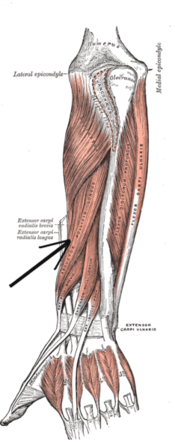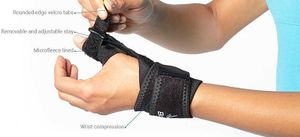Abductor Pollicis Longus: Difference between revisions
No edit summary |
No edit summary |
||
| (19 intermediate revisions by 5 users not shown) | |||
| Line 1: | Line 1: | ||
<div class="editorbox"> | <div class="editorbox"> | ||
'''Original Editor '''- [[User:Name here| | '''Original Editor '''- [[User:Name here|Vidhu Sindwani]] | ||
'''Top Contributors''' - {{Special:Contributors/{{FULLPAGENAME}}}} | '''Top Contributors''' - {{Special:Contributors/{{FULLPAGENAME}}}} | ||
</div> | </div> | ||
== Description == | == Description == | ||
The Abductor pollicis longus (APL) is one of a deep extensor of the forearm and is responsible for facilitating movement and stabilization of the thumb. | The Abductor pollicis longus (APL) is one of a deep extensor of the forearm and is responsible for facilitating movement and stabilization of the thumb. Its [[Tendon Anatomy|tendon]] is present in the first extensor compartment of the wrist.<ref>Tewari J, Mishra PR, Tripathi SK. [https://link.springer.com/article/10.4103/0019-5413.164038 Anatomical variation of Abductor pollicis longus in Indian population]: A cadaveric study. Indian J Orthop 2015;49:549-53</ref> It lies immediately below the [[supinator]] and sometimes unites with it. The muscle belly consists fundamentally of three parts which results in two divisions of tendons. <ref name=":0">Elvire Van Oudenaarde. [https://scholar.google.com/scholar_url?url=https://www.ncbi.nlm.nih.gov/pmc/articles/PMC1256056/&hl=en&sa=T&oi=gsb&ct=res&cd=0&d=7343755656359123663&ei=43n_Y-2IOIjeygTN9LHQDg&scisig=AAGBfm2Jqog-m-gal52uZLJvdKYPgEF_Gw Structure and function of abductor pollicis longus muscle.] Journal of Anatomy. 1991, 174: 221-227</ref> | ||
== Origin & Insertion == | |||
[[File:Abductorpollicislongus.png|thumb|448x448px]]The first part of the abductor pollicis muscle is a deep part which originates from the [[ulna]], interosseous membrane, and [[radius]] and is covered by [[Extensor Digitorum Longus]]. It has numerous subdivisions of the belly (all arranged in a parallel fashion) which terminates in a central tendon. The fibers of the first part are short, obliquely attached to a tendon in a pennate fashion. After its passage through the first compartment of the extensor retinaculum, the deep tendon separates into several branches and is ultimately inserted into the [[trapezium]], abductor pollicis brevis, opponens pollicis, capsule, and anterior oblique ligament.<ref name=":0" /> | |||
The other two parts of abductor pollicis longus are superficial. One of them originates from the ulna and interosseous membrane whereas the other originates from the deep fascia of the forearm and the radius. These two parts are connected to the third deep part by a small area of connective tissues and terminate in a tendon to metacarpal 1<ref name=":0" />. | |||
The | |||
== | == Nerve Supply == | ||
It | It is supplied by the Posterior Interosseous nerve (C7-C8) which is a continuation of the deep branch of the [[Radial nerve]].<ref>Abrams RA, Ziets RJ, Lieber RL, Botte MJ. [https://scholar.google.com/scholar_url?url=https://www.sciencedirect.com/science/article/pii/S0363502397801578&hl=en&sa=T&oi=gsb&ct=res&cd=0&d=1368934627805298705&ei=CXr_Y9vHBomwywSdlrLQBQ&scisig=AAGBfm3rFROoNnSfg453A8cct6VpwDpA6Q Anatomy of the radial nerve motor branches in the forearm]. The Journal of Hand Surgery 1997 Mar;22A(2):232-37</ref> | ||
== | == Artery == | ||
Posterior interosseous artery<ref>Department of Radiology, University of Washington. Abductor pollicis longus. https://rad.washington.edu/muscle-atlas/abductor-pollicis-longus/ (accessed on 11 Nov 2017)</ref> | |||
== | == Function == | ||
<br> | <br>The main functions of APL include the abduction of the thumb and extension of the first carpometacarpal joint. It also assists in radial deviation and flexion of the wrist.<ref name=":1">Kendall FP, McCreary EK, Provance PG, Rogers MM, Romany WA. [https://www.ncbi.nlm.nih.gov/pmc/articles/PMC1858872/ Muscles testing and function with posture and pain]. 5th ed. USA: Lippincott Williams & Wilkins; 2005. 261p</ref> | ||
== | == Clinical Relevance == | ||
The | The most important clinical condition involving the APL, usually along with the Extensor pollicis brevis is the DeQuervain's Syndrome. It is characterized by thickening and inflammation of tendons of APL and EPB resulting in pain and swelling in the first extensor compartment of the wrist. Pain increases on movements of the thumb making the tendons more susceptible to degeneration and lesions<ref>Rosa RC, de Oliveira KM, Leo JA, Elias BA, dos Santos PR, de Santiago HA. [https://scholar.google.com/scholar_url?url=https://www.scielo.br/j/rbort/a/jtYk6sYddF9XPFZdRh9hwFn/abstract/%3Flang%3Den&hl=en&sa=T&oi=gsb&ct=res&cd=0&d=5400861051167429242&ei=ZHr_Y5nHA5n0yAT_xK_ADg&scisig=AAGBfm2FMLb7mqbiWR7ABw7MvIxU7MNDjA Anomalous bilateral contribution of extensor pollicis longus and muscle fusion of the first compartment of the wrist.] Rev Bras Ortop 2016;51(2):235-38</ref>. | ||
== | == Assessment == | ||
The | The strength of APL is assessed by asking the subject to abduct the thumb with the forearm in a neutral position. Resistance is applied against the lateral aspect of the distal end of first metacarpal in the direction of the adduction of the thumb.<ref name=":1" /> | ||
The test used for the clinical diagnosis of DeQuervains is known as Finklestein's test. The patient is asked to make a fist with the thumb inside the fingers. The therapist/examiner passively deviates the wrist to the ulnar side. A positive test is indicated by pain over the radial styloid process at the site of the tendons of APL and EPB.<ref>Arend CF. [https://scholar.google.com/scholar_url?url=https://www.scielo.br/j/rb/a/WW4JLMnLX8Zr8cLbdtpRGMR/%3Flang%3Den&hl=en&sa=T&oi=gsb-ggp&ct=res&cd=0&d=8389432619105391649&ei=enr_Y_KJNc6bywTVg7Fo&scisig=AAGBfm0e1fzmp5I_-vcDPeGeB5IY4LYzcw Tenosynovitis and synovitis of the first extensor compartment of the wrist]: what sonographers should know. Radiol Bras 2012;45(4):219-224</ref>{{#ev: youtube | 8WBVXBx34W0}}<ref>Physiotutors. Finkelstein Test | De Quervain's Tenosynovitis. Available from:https://youtube/8WBVXBx34W0[Accessed 02/09/2020]</ref> | |||
{{#ev: youtube | l_9Suv0xhmY}}<ref>Physiotutors.Eichhoff's Test | De Quervain's Tenosynovitis. Available from:https://youtu.be/l_9Suv0xhmY[Accessed 02/09/2020]</ref> | |||
The test used for clinical diagnosis of DeQuervains is known as | == Treatment == | ||
Management of DeQuervain's syndrome would depend on the severity of the condition and can include<ref>Morphopedics. Physical therapy management of DeQuervai's disease. http://morphopedics.wikidot.com/physical-therapy-management-of-de-quervain-s-disease-tenosyn (accessed on 11 Nov 2017)</ref>: | |||
== Treatment<ref>Morphopedics. Physical therapy management of DeQuervai's disease. http://morphopedics.wikidot.com/physical-therapy-management-of-de-quervain-s-disease-tenosyn (accessed on 11 Nov 2017)</ref> | |||
# Electrotherapy modalities including local Ultrasound and TENS application | # Electrotherapy modalities including local Ultrasound and TENS application | ||
# Cold packs/heat packs | # Cold packs/heat packs | ||
# Manual therapy including myofascial release of the tendons and stretching | # Manual therapy including the myofascial release of the tendons and stretching | ||
# | # Strength training for long-standing conditions. | ||
# Thumb splinting, medication and taping can be done for very painful or acute cases | # Thumb splinting(thumb spica), medication, and taping can be done for very painful or acute cases. | ||
[[File:Bioskin-Thumb-Splint.jpg|thumb|Thumb Splint for De Quervain's Syndrome]] | |||
== References == | |||
[[Category:Anatomy]] [[Category:Muscles]] | <references /> | ||
[[Category:Anatomy]] | |||
[[Category:Muscles]] | |||
[[Category:Hand]] | |||
[[Category:Hand - Anatomy]] | |||
[[Category:Hand - Muscles]] | |||
Latest revision as of 18:04, 1 March 2023
Original Editor - Vidhu Sindwani
Top Contributors - Vidhu Sindwani, Kim Jackson, Chrysolite Jyothi Kommu, Chelsea Mclene and Priya Gulla
Description[edit | edit source]
The Abductor pollicis longus (APL) is one of a deep extensor of the forearm and is responsible for facilitating movement and stabilization of the thumb. Its tendon is present in the first extensor compartment of the wrist.[1] It lies immediately below the supinator and sometimes unites with it. The muscle belly consists fundamentally of three parts which results in two divisions of tendons. [2]
Origin & Insertion[edit | edit source]
The first part of the abductor pollicis muscle is a deep part which originates from the ulna, interosseous membrane, and radius and is covered by Extensor Digitorum Longus. It has numerous subdivisions of the belly (all arranged in a parallel fashion) which terminates in a central tendon. The fibers of the first part are short, obliquely attached to a tendon in a pennate fashion. After its passage through the first compartment of the extensor retinaculum, the deep tendon separates into several branches and is ultimately inserted into the trapezium, abductor pollicis brevis, opponens pollicis, capsule, and anterior oblique ligament.[2]
The other two parts of abductor pollicis longus are superficial. One of them originates from the ulna and interosseous membrane whereas the other originates from the deep fascia of the forearm and the radius. These two parts are connected to the third deep part by a small area of connective tissues and terminate in a tendon to metacarpal 1[2].
Nerve Supply[edit | edit source]
It is supplied by the Posterior Interosseous nerve (C7-C8) which is a continuation of the deep branch of the Radial nerve.[3]
Artery[edit | edit source]
Posterior interosseous artery[4]
Function[edit | edit source]
The main functions of APL include the abduction of the thumb and extension of the first carpometacarpal joint. It also assists in radial deviation and flexion of the wrist.[5]
Clinical Relevance[edit | edit source]
The most important clinical condition involving the APL, usually along with the Extensor pollicis brevis is the DeQuervain's Syndrome. It is characterized by thickening and inflammation of tendons of APL and EPB resulting in pain and swelling in the first extensor compartment of the wrist. Pain increases on movements of the thumb making the tendons more susceptible to degeneration and lesions[6].
Assessment[edit | edit source]
The strength of APL is assessed by asking the subject to abduct the thumb with the forearm in a neutral position. Resistance is applied against the lateral aspect of the distal end of first metacarpal in the direction of the adduction of the thumb.[5]
The test used for the clinical diagnosis of DeQuervains is known as Finklestein's test. The patient is asked to make a fist with the thumb inside the fingers. The therapist/examiner passively deviates the wrist to the ulnar side. A positive test is indicated by pain over the radial styloid process at the site of the tendons of APL and EPB.[7]
Treatment[edit | edit source]
Management of DeQuervain's syndrome would depend on the severity of the condition and can include[10]:
- Electrotherapy modalities including local Ultrasound and TENS application
- Cold packs/heat packs
- Manual therapy including the myofascial release of the tendons and stretching
- Strength training for long-standing conditions.
- Thumb splinting(thumb spica), medication, and taping can be done for very painful or acute cases.
References[edit | edit source]
- ↑ Tewari J, Mishra PR, Tripathi SK. Anatomical variation of Abductor pollicis longus in Indian population: A cadaveric study. Indian J Orthop 2015;49:549-53
- ↑ 2.0 2.1 2.2 Elvire Van Oudenaarde. Structure and function of abductor pollicis longus muscle. Journal of Anatomy. 1991, 174: 221-227
- ↑ Abrams RA, Ziets RJ, Lieber RL, Botte MJ. Anatomy of the radial nerve motor branches in the forearm. The Journal of Hand Surgery 1997 Mar;22A(2):232-37
- ↑ Department of Radiology, University of Washington. Abductor pollicis longus. https://rad.washington.edu/muscle-atlas/abductor-pollicis-longus/ (accessed on 11 Nov 2017)
- ↑ 5.0 5.1 Kendall FP, McCreary EK, Provance PG, Rogers MM, Romany WA. Muscles testing and function with posture and pain. 5th ed. USA: Lippincott Williams & Wilkins; 2005. 261p
- ↑ Rosa RC, de Oliveira KM, Leo JA, Elias BA, dos Santos PR, de Santiago HA. Anomalous bilateral contribution of extensor pollicis longus and muscle fusion of the first compartment of the wrist. Rev Bras Ortop 2016;51(2):235-38
- ↑ Arend CF. Tenosynovitis and synovitis of the first extensor compartment of the wrist: what sonographers should know. Radiol Bras 2012;45(4):219-224
- ↑ Physiotutors. Finkelstein Test | De Quervain's Tenosynovitis. Available from:https://youtube/8WBVXBx34W0[Accessed 02/09/2020]
- ↑ Physiotutors.Eichhoff's Test | De Quervain's Tenosynovitis. Available from:https://youtu.be/l_9Suv0xhmY[Accessed 02/09/2020]
- ↑ Morphopedics. Physical therapy management of DeQuervai's disease. http://morphopedics.wikidot.com/physical-therapy-management-of-de-quervain-s-disease-tenosyn (accessed on 11 Nov 2017)








